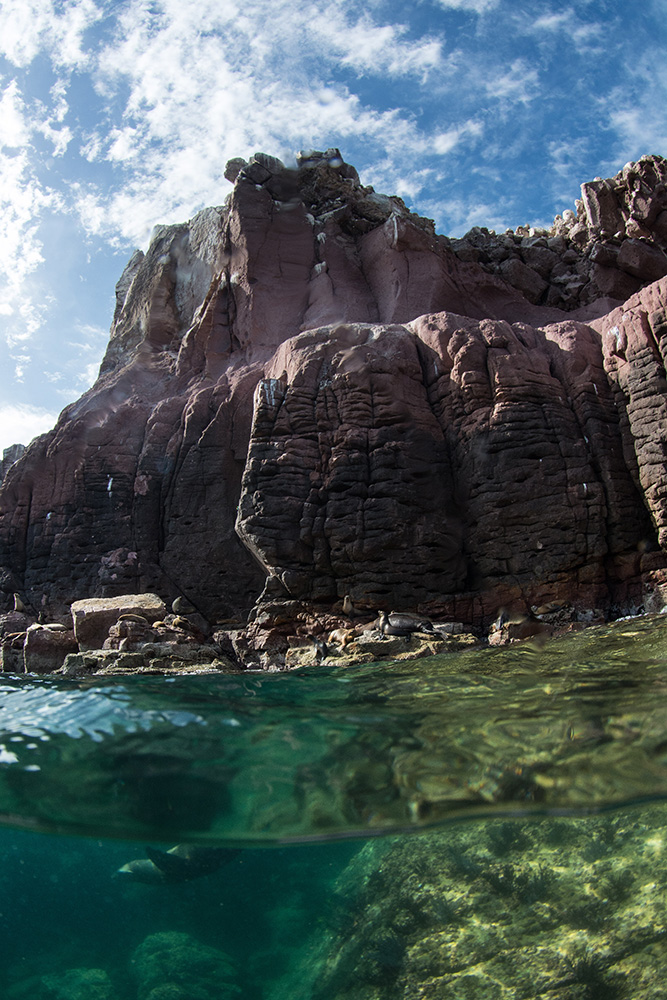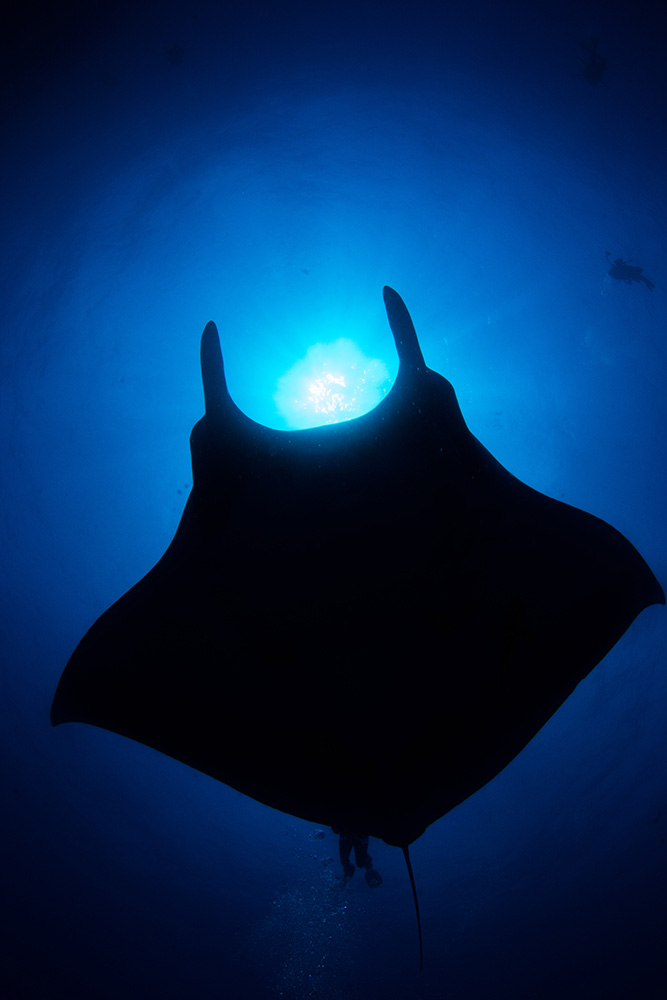The Magic of Ambient Light – Underwater Photography Without Strobes
Lighting is the first thing we learn when we pick up a camera to shoot underwater photos. It’s drilled in to us that light just doesn’t penetrate the water column and color starts to fade the minute we start diving so we need artificial light to get a good photo. For many of us, we couldn’t even imagine not diving with our strobes, but what if we did, what if we just left them on the boat? Why the heck would we even want to do that?
Well, we’re about to step out of our comfort zone and in to a different way to shoot underwater.
The first thing you notice is how easy it becomes to maneuver without those strobes and arms dragging thru the water.
The first thing you notice is how easy it becomes to maneuver without those strobes and arms dragging thru the water. You go from being a wide load truck cutting inefficiently thru the water to a nice, zippy sports car. It’s super weightless and in a sport that tends to be weight predominant, it sure does feel good to drop some of the load! And what about those top down photos, they have never been easier without having to kick out of the water to get your heavy rig at just the right spot to take that shot. Also, strobes only reach so far to get a good result so unless that whale is coming in to give you a kiss, chances are you will be lugging around your strobes for nothing.
So how do you figure out what settings to use when you dive without your strobes?
When you’re snorkeling on the surface or freediving below the surface, ambient light is an amazing tool you can use to your advantage when trying to get your shot. Figuring out your settings will depend on several things, how much sunlight you have to work with, what’s your subject and are they moving fast or slow, what’s the water visibility and quality as well as how deep will you be diving. The great thing is when you leave the strobes behind; it forces you to get to know your camera and its manual and semi-auto settings. Since you will have to rely on ambient light and your camera for lighting the shot, ISO, aperture and shutter speed become your best friends.
By learning these settings, you can push the limits of your camera to achieve what your vision is saying to you. When your camera is in auto mode, it makes all of your decisions and many times you are envisioning something completely different.
In a perfect situation, the sun will be out, the water will be blue and clear, you’ll be snorkeling and your subject will be not be moving too fast. We would want to use as much sunlight as we can while still getting the blue water and the animal in focus. We’ll start out at F16 at 1/125th with an ISO 100. I would then take a light meter reading and see where I fall.
The fun part starts with what is the shot I’m trying to get and what piece of the puzzle determines what I want to shoot. I want the turtle to be in focus so I’m not going to slow down my shutter speed any more than 1/125th but I need a bit more light so where can I get it? I can open up my aperture a bit, maybe down to F11 but I have some room also with my ISO so that can be bumped up to 250. If I did want to have a bit of blur I could slow down my shutter speed to maybe 1/60th but then I’d have too much light so I might have to reduce my ISO back down to 100.
I shot the top down shot in La Paz at Isla Espiritu Santo and it was a very sunny day so you would think I would have closed down my aperture but I shot this shot at F8 at 1/500th at ISO 400. I mainly wanted to get the sky blue, clouds crisp with no blur and possible sun rays while the water was a bit murky so this combo worked best for me.
So now let’s take a dive and we are either going to freedive or scuba dive with our marine friends. We’re now losing the amount of ambient lighting we had at the surface. It’s still sunny out in our scenario but the neat thing is we can still get some of the sunlight and there’s the possibility of getting some sun rays as well in the shot.
I would start out at F11 at 1/125th again, for no blur, and I would probably start my dive at ISO250. I would take a meter reading and see where my base would be, and again, decide what I’m trying to achieve with the shot. I ended up deciding to work on a silhouette of the manta and I ended up bumping my shutter to 1/500th to meter on the background and get that deep blue with the sun ball with hopefully some sun rays and I pushed my aperture to as small as I could at F22 but left my ISO at 640. It definitely gave me the blue I was looking for and the sun with some rays shooting around the manta.
Many times we get that weird blue hue when taking a photo at depths without strobes, however, with the right combination, the blue works with the shot.
So now let’s take a shot where we have removed color from the equation. Wait a minute, isn’t color why we photograph underwater subjects?
Well, yes, but what if you remove the color, what does that leave you with? You now have to really look at the subject and figure out why you like the photo, what draws you to the subject and why.
Is it the patterns and textures or the symmetry of the subject? What made you stop to take the picture? By taking a few seconds and thinking about why you like the shot, it helps you figure out the real reason why you stopped in the first place. It’s just another way of capturing your vision.
When I was diving at Socorro Island, it was cloudy and we were scuba diving at depths between 40-80 feet, so I had to decide how I wanted to shoot the mantas that were swimming all around us. Strobes were pretty useless when trying to shoot these amazing animals and they were going at a pretty good speed. I ended up having to have my shutter up a bit at 1/400th and I had to bump up my ISO to 800 and aperture to F5.6 to compensate. I definitely got some grain so I did end up converting the photo to black and white. By converting it to black and white, I was able to really show off this manta’s patterns and isolate him/her from the water column if it had been in color and look how its features pop out. I love how the eyes are so prominent in the photo.
How about that playful sea lion stopping and wanting to play right in front of you? They pretty much are a low key color so why not take the color out of the mix and concentrate on their big puppy-dog eyes and fanning whiskers instead?
Sea lions tend to also kick up a lot of backscatter and without your strobes, you won’t be illuminating the particles and dirtying up your shot. These guys are so fast and were hanging out just below the surface so I had to bump up my shutter speed to 1/400th which cut off my light and I kept my ISO at 200 so I worked on using my aperture to play with and I ended up going down to F4.5. I was able to keep the background from blowing out, freeze the sea lion and maintain minimal grain. I did sacrifice my depth of field but I really only wanted the cute face in the frame so that worked out well.
Not every dive is a “strobe less” dive but by shaking things up once in a while and leaving them on the boat, you might be pleasantly surprised how much you like not using them to create your vision.
Have any questions about shooting in ambient light? Ask us in the comments below! We’d love to help 🙂
- Photographing the Mysterious, Beautiful, Pelagic Invertebrates – August 25, 2022
- The Subtle Art of Close Focus Wide Angle – July 8, 2021
- Shooting Wide Angle In Bad Visibility – October 14, 2020

 CAD
CAD





4 comments
Hey Michelle
Great article!!
Thanks for sharing
A great article, but I wonder how you get such fast shutter speeds! I regularly shoot without strobes, but even at ISO 400-800 and F4.5(ish) I struggle to get better than 1/60. Frequently it’s around 1/20, which is simply unusable even on stationary subjects when surge is moving you around. Sometime I have to shoot in shutter priority to fix a shutter speed, take a massively underexposed photo, and then lighten it up in post processing (which might leave it more noisy or losing colour).
My camera is an Olympus E-PL5. I’m typically shooting in 5-10m visibility, and either in the shadow of a pier or in the open ocean at 15-45m depth (often under reef overhangs).
Great article Michelle!! I completely agree.
I only take pictures with ambient light. It is my ethical choice as my full respect of the whole Marine Life.
I have learned to get a lot of stunning natural colours with the help of a small white slate to take the manual white balance before every shot, if it is possible. It is like to bring the Underwater World out in the sunlight!!
Thanks, Tracy!!!